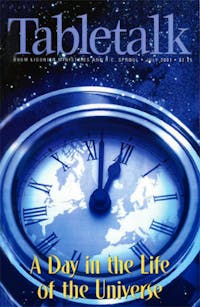
Request your free, three-month trial to Tabletalk magazine. You’ll receive the print issue monthly and gain immediate digital access to decades of archives. This trial is risk-free. No credit card required.
Try Tabletalk NowAlready receive Tabletalk magazine every month?
Verify your email address to gain unlimited access.
If there is any place where the bone-chilling ugliness of our modern world is both displayed and advanced, it is in the liturgical poverty of the modern evangelical world. And surprisingly, one of the reasons for this is the church’s embarrassment over the doctrine of Creation ex nihilo. We have a real problem with this. On the one hand, we can see fundamentalists who do assert Creation from nothing, but whose anti-intellectualism elsewhere prevents them from enjoying the fruit of this doctrine. On the other hand, we see erstwhile Reformed sophisticates who have all the worldview trimmings in place—pipes, tobacco, matches, and all—but who are embarrassed by this glory of the Christian faith.
The basic issue with an “old earth” is not time but distance. When the ex nihilo business is that far away, we do not have to look at it closely.
Make no mistake—an important key to preserving orthodoxy (and all resultant loveliness) lies in understanding and fiercely defending these two words—ex nihilo. The pagan hates the idea of Creation because of the divine sovereignty that follows from it, but he loves the idea of morphing—re-arranging stuff. Ovid has this in common with the Mormons, who share it with process theologians, who are trying to pass these doctrinal cooties to evangelicalism.
In anti-Christian thought, matter is this eternally existent Play-Doh-type stuff that can be re-arranged creatively by other bits of stuff called artists or scientists. This is possible because the splendor is thought to be resident within the matter. The autonomous artist assumes he is the point on the surface of the chaos where the gods spring forth.
According to the Scriptures, God created the heavens and the earth from nothing. Man was told to till the ground—rearrange dirt. But in faithful re-arranging, a garden flourishes. Because sin entered the world, and because our generation is industriously trying to make the serpent’s lie work, our situation is different. Man pretends to be as God, to create from nothing, from the mysterious recesses of his creative little soul. Whether that soul works in a laboratory or an artist’s studio does not matter. This soul, remember, is the place where the Play-Doh produces divinity.
A man who stands on matter that was “always there” has to pretend somehow that spontaneous beauty can burst forth ex nihilo propinquiter—from nothing, kinda. This, incidentally, parallels the big bang theory, where all things that are happened to explode out of an “almost nothing” mathematical point-like thingy. And as another aside, our modern aesthetic poverty and our corresponding liturgical poverty arise from the self. Our modern religion tells us the self is a vast and limitless resource, while all our philosophers tell us that they don’t really know what the self is. When we look inside, we can’t see. It’s dark in there. But if we look out, we see all this stuff that God made.
Our Lord Jesus teaches us over and over that the first will be last and the last first. He says the way to authority is through service, and that the humble will be exalted. He says this kind of thing so often that we Christians should be learning how His mind works; we should be learning to anticipate Him in things like this. True “creaturely” creativity of any kind (aesthetic, liturgical, etc.) must therefore come from acknowledging that God is the only one who is creative ex nihilo. Those who lose their lives for Christ’s sake find them. In the same way, those who abandon all hope of autonomous creativity amaze the world with their creativity. The one who is creative is the one who knows he cannot be.
For this doctrine to have this force, it must be before us constantly. It belongs in our worship, and should make a weekly appearance there. In our prayers of praise, in our hymns, in our confession, in the sermons, in the words that accompany the Lord’s Supper, the Creator God should be worshiped in what He has done. We need a lot more of the created world in our worship, with the trees clapping their hands far better than Reformed folk usually do.
This means that the doctrine of Creation is not something that should embarrass us (“What if a professor of microbiology visits the church?!”), and neither should it be relegated to the reservation of Creation/evolution conferences. These are fine, but the point should be to try to incorporate a constant refrain of creaturely gratitude into the worship.
As we do these things, they will begin to color the liturgy. And as the liturgy becomes increasingly God-centered and majestic, we will discover that all our evangelical ticky-tacky ugliness does not feel at home quite like it used to. And as the liturgy of the Reformed churches becomes breathtakingly lovely, the effect on the surrounding and watching world will be remarkable.
